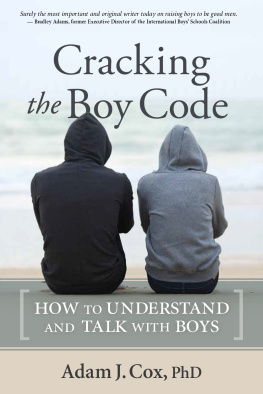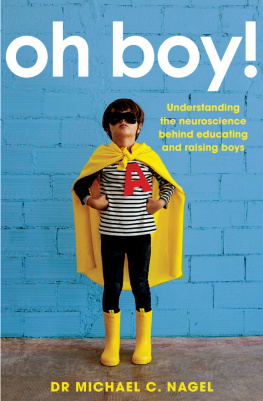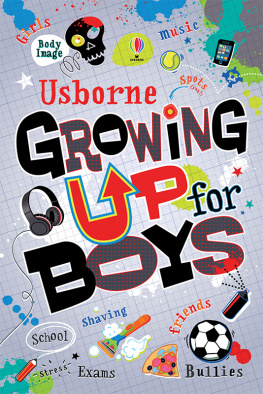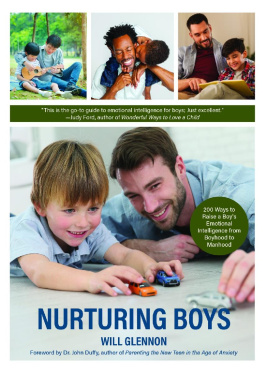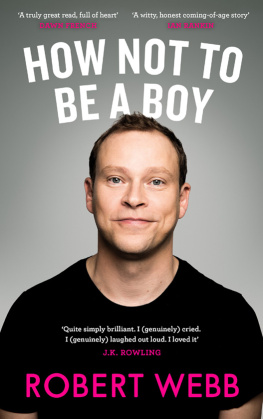Praise for
Cracking the Boy Code
Adam Cox unpacks in simple language the intricacies of communicating with boys. As a teacher of boys I learnt from every page the book is an educational revelation resulting from remarkable face to face research, and provides an exceptional tool to help parents and teachers understand what makes boys tick.
David Anderson B.A, Dip TG, B.Ed, Cert. of Care, Sydney Australia IBSC Jarvis/Hawley Award Baltimore USA 2017
Cracking the Boy Code offers a thoughtful, accessible guide to developing meaningful communication with the boys in our lives. Adam Coxs insights, grounded in practical wisdom cultivated over decades of clinical work with boys, provide readers with compelling possibilities for using non-verbal cues, tone of voice, hands-on activity, and empathetic listening to connect with boys in a manner both deep and enduring. Above all, Cracking the Boy Code recognizes that boys have a lot on their minds, and urges all of us to take them seriously as potential partners in dialogue. Dr. Coxs latest work is both inspiring and instructive.
Dr. John M. Botti, Head of School, The Browning School
Adam Coxs Cracking the Boy Code will become a go to resource for parents, caregivers, teachers and professionals. His deep understanding of boys and how to provide what they need from the adults in their lives, is reflected in each chapter with positive, sage advice and strategies. The real benefactors of this book will be boys, who have adults in their lives who read this book!
Mary Gauthier: Executive Director, Greenwood Centre for Teaching and Learning, Greenwood College School, Toronto
Adam Cox is surely the most important and original writer today on raising boys to be good men. Cracking the Boy Code is full of wisdom about the way boys communicate, think and relate. This is a powerful guide for parents, educators and counselors who strive to help boys be their best selves.
Bradley Adams is the past Executive Director of the International Boys Schools Coalition and is now an educational consultant.
Copyright 2018 by Adam Cox.
All rights reserved.
Cover design by Diane McIntosh.
Cover image: iStock (621379294)
Text box background: adobeStock (75003007)
Printed in Canada. First printing April 2018.
Inquiries regarding requests to reprint all or part of Cracking the Boy Code should be addressed to New Society Publishers at the address below. To order directly from the publishers, please call toll-free (North America) 1-800-567-6772, or order online at www.newsociety.com
Any other inquiries can be directed by mail to:
New Society Publishers
P.O. Box 189, Gabriola Island, BC V0R 1X0, Canada
(250) 247-9737
LIBRARY AND ARCHIVES CANADA CATALOGUING IN PUBLICATION
Cox, Adam J., author
Cracking the boy code : how to understand and talk with boys / Adam J. Cox, PhD.
Includes index.
Issued in print and electronic formats.
ISBN 978-0-86571-876-0 (softcover).--ISBN 978-1-55092-669-9 (PDF).-
ISBN 978-1-77142-264-2 (EPUB)
1. Boys. 2. Child rearing. 3. Communication in families. I. Title.
HQ775.C69 2018 | 649.132 | C2017-907591-8 C2017-907592-6 |

New Society Publishers mission is to publish books that contribute in fundamental ways to building an ecologically sustainable and just society, and to do so with the least possible impact on the environment, in a manner that models this vision.

Contents
Prologue
T HIS IS A BOOK ABOUT RELATING TO AND TALKING with boys. Ive written this book for you. If you have gotten only this far, I know you must share my concerns. For most of my 20 years as a psychologist, the social and emotional development of boys how to help boys become capable and confident young men has been a primary interest. Cracking the Boy Code is also a lens for looking at boyhood itself; it makes little sense to suggest how to connect more effectively with boys without also saying something about their psychology.
Some people believe that boys have already been the subject of too much writing. I strongly disagree. Otherwise, we are accepting a discussion of boys behavior problems as all we need to know about who boys are as people. There is so much more to the psychology of boys than behavioral challenges, and that psychology is much more interesting than you might expect.
The way into this story the most illuminating way to know boys is to talk with them. The pages that follow may challenge you to relate to someone who may be different than you. And so, Cracking the Boy Code is also about life: how different members of a family coexist, get along, and love each other. Compassion and respect for young people is the nitro fuel that gives all the suggestions in this book a chance to work.
You may be encountering the challenge of communicating with boys for the first time. Or perhaps youve been communicating with mixed success for a long time. That was me, some years ago. Almost as soon as I was licensed to practice psychology, people in my community urged me to work with school-age boys. As I am a male therapist, perhaps this was inevitable. Some were emphatic that boys issues were an important area of need, and that thered be no shortage of clients in my fledgling counseling practice. Id already worked with noncommunicative men in different settings: with hardened combat veterans at a US Veterans Administration clinic, visual artists more comfortable sharing images than words at a college counseling center, and very disabled inpatients at a psychiatric hospital. Seeing the need in my community, I accepted the challenge of building a practice around the social and emotional needs of boys, and especially their difficulties with communication. How hard could it be? Well, it was much harder than I thought, and also more rewarding.
My first book, Boys of Few Words, was about this work and the difficulties faced by different types of boys (shy, angry, or with learning disabilities). In Cracking the Boy Code, I want to describe our challenges in communicating with boys. Even after working with boys for several years, counseling them, evaluating them for ADHD and learning challenges, and advising schools on how best to educate them, it was not until I attempted to work with boys in groups that I fully grasped the best way to connect with their psychology. This includes the best way to communicate with and know boys.
Let me describe what happened to me. Several schools near where I was practicing psychology became aware of my work with school-age boys, and asked me to start a social skills group for kids between the ages of 9 and 12. Most of these boys had some type of learning disability or ADHD, and all struggled with some degree of social awkwardness. It seemed like a natural fit for my professional interests, and Id been working with socially challenged men for several years.
Parents were enthusiastic, and the group quickly enrolled. Unfortunately, it became apparent that the boys were not nearly as enthusiastic as their parents. Greeting the young members of my group in the waiting room, they sat with arms folded, grim expressions, and little eye contact. As I escorted the group of boys to my office I could sense them trudging along with a combination of dread and boredom. That was pretty much the tone of the groups in those early days. The boys didnt want to be there, and soon I didnt want to be there either. Over a few weeks, I went from feeling confident and enthusiastic, to feeling frustrated and irritable. If youve ever felt the sting of kids who dont return your enthusiasm for something thats very important to you, then you know what Im talking about.
Next page
